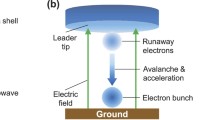Summary
The observational parameters of ball lightning are given, together with an analysis of electrical processes during the origin and evolution of ball lightning. It is suggested that ball lightning formation takes place in a unipolar plasma with a high concentration of charged particles. According to the analysis such a plasma is formed as a results of electric breakdown of atmospheric air between a dust cloud and a hard surface. A comparison is made between observational ball lightning as a light source, a black body and a flame. It is shown that the luminosity of ball lightning is created by separated hot regions with a temperature of about 2000 K. Excited atoms or molecules in these regions are found in thermodynamical equilibrium with air. The waves of ball lightning luminosity spread along separated threads of the active substance of ball lightning, with some 102⋎104 threads being involved in this process. The luminisity of many points is perceived as a volume radiation of ball lightning.
Riassunto
Si danno i parametri d’osservazione del ball lightning insieme ad un’analisi di processi elettrici durante la sua origine e evoluzione. Si suggerisce che la sua formazione avvenga in un plasma unipolare con alta concentrazione di particelle cariche. Secondo l’analisi tale plasma si forma in quanto risultato di una scarica disruttiva di aria atmosferica tra una nuvola di polvere e una superficie dura. Si fa un confronto tra il ball lightning osservato come fonte di luce, un corpo nero e una fiamma. Si mostra che la luminosità del ball lightning si crea da regioni calde separate con una temperatura di circa 2000 K. Si trova che atomi eccitati o molecole in queste regioni sono in equilibrio termodinamico con l’aria. Le onde di luminosità del ball lightning si diffondono lungo fili separati della sostanza attiva del ball lightning con circa (102⋎104) fili coinvolti in tale processo. La luminosità di molti punti è percepita come radiazione di volume del ball lightning.
Резюме
Приводятся наблюдаемые параметры шаровой молнии. Анализируются электрические процессы при образовании и эволюции шаровой молнии. Предполагается, что шаровая молния образуется в униполярной плазме с высокой концентрадией заряженных частиц. Согласно проведенному анализу, такая плазма образуется в резяльтате электрического пробоя атмосферного воздуха между рылевым облаком и твердой поверхностью. Проводится сравнение наблюдаемой шаровой молнии, как источника света, света, с черным телом и с пламенем. Показывается, что излучение шаровой молнии обрззуется отдельными горячими областями с температурой около 2000 К. Отмечается, что возбужденые атомы или молекулы в этих областях находятся в термодинамическом равновесии с воздухом. Волны илучения шаровой молнии распространяются вдоль отдельных нитей активного вещества шаровой молнии, причем в процессе участвует порядка 102⋎104 нитей. Светимость большого числа точек воспринимается как объем излучения шаровой молнии.
Similar content being viewed by others
References
J. R. McNally: Oak Ridge National Laboratory Report, ORNL-3938, 1966.
W. D. Rayle: NASA Tech. Note, NASA-TN-D3188, 1966.
W. D. Charman:Phys. Rep.,54, 261 (1979)
I. P. Stakhanov:About Physical Nature of Ball Lightning (Energoatomizdat, Moscow, 1985, in Russian).
S. Singer:The Nature of Ball Lightning (Plenum Press, New York, N.Y., 1971).
S. Singer:Lightning, edited byR. H. Golde (Academic Press, London, 1977), p. 409.
J. D. Barry:Ball Lightning and Bead Lightning (Plenum Press, New York, N.Y., 1980).
B. M. Smirnov:Phys. Rep.,152, 177 (1987).
B. M. Smirnov:Sov. Phys. Usp.,29, 481 (1986).
Y. H. Ohtsuki andH. Ofuruton:Nuovo Cimento C,10, 577 (1987).
B. M. Smirnov:Sov. Phys. Usp.,18, 636 (1975).
V. Ya. Alexandrov, E. M. Golubjev andI. V. Podmoshenskij:Sov. Phys. Tech. Phys.,27, 1221 (1982).
V. Ya. Alexandrov, I. P. Borodin, E. V. Kichenko andI. V. Podmoshenskij:Sov. Phys. Tech. Phys.,27, 527 (1982).
S. R. Forrest andT. A. Witten:J. Phys. A,12, L109 (1979).
B. M. Smirnov:Problem of Ball Lightning (Nauka, Moscow, 1988, in Russian).
W. R. Lee:Lightning, edited byR. H. Golde (Academic Press, London, 1977), p. 521.
P. Meakin:Phys. Rev. Lett.,51, 1119 (1983).
M. Kolb andR. Botet:Phys. Rev. Lett.,51, 1123 (1983).
D. Weitz andM. Oliveria:Phys. Rev. Lett.,52, 1433 (1984).
B. M. Smirnov:Sov. Phys. Usp.,21, 133 (1987).
N. A. Fuks:The Mechanics of Aerosol (Macmillan, New York, N.Y., 1964).
N. Y. Krasnogorskaja:Electricity of Low Layers of Atmosphere (Gidrometeoizdat, Leningrad, 1972, in Russian).
A. Hussin:J. Aerosol Sci.,14, 671 (1983).
C. B. Moore andB. Vonnegut:Lightning, edited byR. H. Golde (Academic Press, London, 1977), p. 51.
M. Brook andT. Ogawa:Lightning, edited by R. H. Golde (Academic Press, London, 1977), p. 191.
J. Latham:Q. J. R. Meteorol. Soc.,107, 277 (1981).
E. R. Jayaratne, C. P. R. Saunders andJ. Hallett:Q. J. R. Meteorol. Soc.,109, 609 (1983).
J. E. Dye:J. Geophys. Res.,91, 1231 (1986).
B. J. Mason:The Physics of Clouds (Clarendon Press, Oxford, 1971).
H. Israel:Atmospheric Electricity (Reter Press Binding, Jerusalem, 1973).
B. M. Smirnov:Excited Atoms (Energoatomizdat, Moscow, 1982, in Russian).
A. A. Shidlovskij:Principles of Pyrotechnics (Mashinostroenije, Moscow, 1973; translation Publ. No. ADA 001 859, 1974).
J. H. McLain:Pyrotechnics (Franklin Institute Press, Philadelphia, Penn., 1980).
T. Shimizu:Fireworks, the Art, Science and Technique (Maruzen Co., Tokyo, 1981).
V. N. Kondratjev andE. E. Nikitin:Kinetics and Mechanism of Gaseous Reaction (Nauka, Moscow, 1974, in Russian).
U. Even, K. Rademann, J. Jorther, N. Manor andR. Reisfeld:Phys. Rev. Lett.,52, 2164 (1984).
I. Jackson:Landolt-Bornstein Data, Group V, Vol. 2a (Springer-Verlag, Berlin, 1984), p. 248.
V. P. Krainov, G. P. Lebedev, A. O. Nazarjan andB. M. Smirnov:Sov. Phys. Tech. Phys.,31, 120 (1986).
Author information
Authors and Affiliations
Rights and permissions
About this article
Cite this article
Smirnov, B.M. Electrical and radiative processes in ball lightning. Il Nuovo Cimento C 12, 575–595 (1989). https://doi.org/10.1007/BF02508017
Received:
Revised:
Issue Date:
DOI: https://doi.org/10.1007/BF02508017




